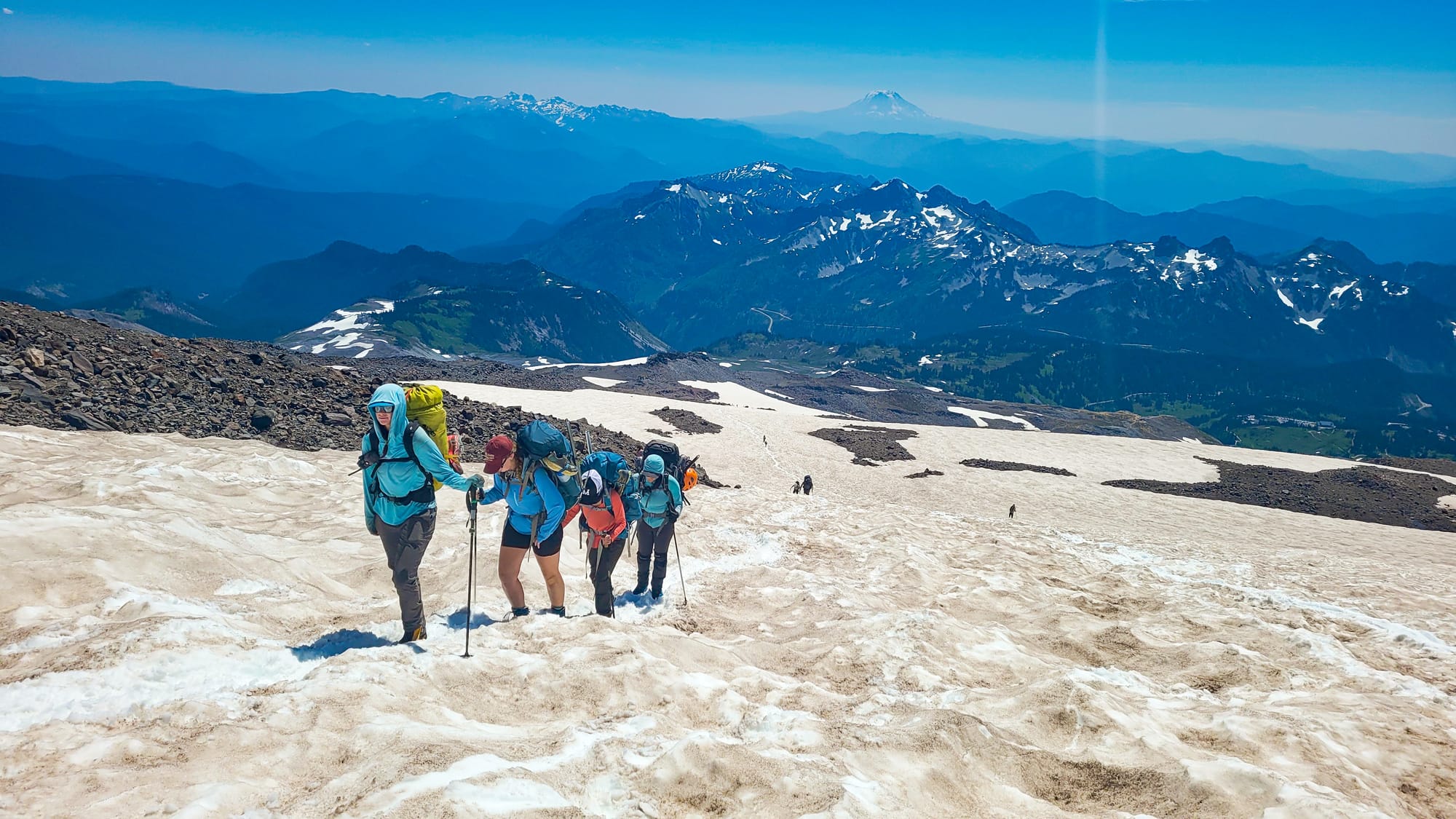Originally written by Alexis Rousek, edited by Avery Stolte.
How to Avoid a UTI or Yeast Infection While Hiking, Camping, and in the Backcountry
Spending time in the mountains, deep in the backcountry, or at a remote alpine basecamp is an incredible experience—but dealing with a urinary tract infection (UTI) or yeast infection in the wilderness? Not so much.
If you’ve ever felt that post-hike discomfort or struggled with an infection while on a multi-day trip, you’re not alone. Nearly 50% of women will experience at least one UTI in their lifetime, and 75% will have a yeast infection at some point. The good news? There are plenty of steps you can take to reduce your risk of developing these common infections while adventuring in the backcountry.
This guide will help you understand:
- How to prevent UTIs and yeast infections while hiking and camping
- Essential hygiene tips for the backcountry
- How to recognize and treat symptoms if you do get an infection
Why Do UTIs and Yeast Infections Happen in the Backcountry?
Many people assume that UTIs and yeast infections result from poor hygiene, but that’s not always the case. Factors like genetics, hormonal changes, diabetes, microbiome imbalances, and dehydration all play a role. However, backcountry conditions—including limited access to clean water, infrequent urination, and prolonged exposure to moisture—can increase your risk.
Both UTIs and yeast infections thrive in environments where bacteria and fungi can grow unchecked, which is why staying dry, hydrated, and mindful of hygiene practices is essential when spending multiple days outside.
How to Prevent a UTI or Yeast Infection While Hiking and Camping
- Stay Hydrated (Yes, Even If It’s Inconvenient)
It’s easy to put off drinking water when you're on a long trek or trying to limit bathroom stops on a high alpine route—but dehydration increases your risk of UTIs. Urine flushes bacteria from the urinary tract, so drinking plenty of water helps prevent infections.
Tip: Carry an easy-access water bottle or hydration bladder to sip frequently. If you’re in an area with unreliable water sources, bring a lightweight filter to ensure you always have clean water.
- Wipe (Or Rinse) Every Time
Peeing without wiping is common in the backcountry, but moisture buildup and bacteria can lead to infections. If using toilet paper isn’t an option, consider a Kula Cloth or similar reusable pee cloth.
Tip: Always wipe front to back to prevent transferring bacteria to the urethra.
- Choose the Right Underwear
Wearing breathable, moisture-wicking underwear is key to preventing both UTIs and yeast infections. Many synthetic fabrics trap heat and sweat, creating an environment where bacteria and fungi thrive.
Best options: Cotton or merino wool underwear, or brands designed with antimicrobial properties. Avoid: Tight, non-breathable underwear or wearing damp clothing for extended periods.
- Don’t Hold Your Pee
We’ve all been there—telling ourselves we’ll "just wait" until the next rest stop. But holding in urine gives bacteria more time to multiply, increasing your risk of infection.
Tip: If you’re in an area without much privacy, consider using a pee funnel (like a GoGirl, SheWee, or pStyle) to make it easier to go when needed.
- Use Wet Wipes for Daily Cleaning
Since soap and running water aren’t always an option, carrying a few hypoallergenic, unscented wet wipes can help keep you clean. Wiping once a day—especially before bed—can reduce bacteria buildup and keep you feeling fresh.
Tip: Pack extra wipes in case you need them, and always carry a sealed waste bag to pack them out responsibly.
- Change Period Products Regularly
If you’re on your period, changing your pad, tampon, or menstrual cup frequently is essential. Leaving them in for too long creates the perfect environment for bacteria to grow.
Tip: If using a menstrual cup, wash it with clean, boiled, or filtered water before reinserting.
- Be Mindful of Backcountry Sex
It may not be the first thing on your mind while adventuring, but if you do choose to have sex in the backcountry, know that it can increase your risk of UTIs and yeast infections—especially if proper hygiene isn’t possible.
Prevention tip: Pee before and after sex, use a wet wipe for cleaning, and change into clean, dry underwear afterward.
Recognizing a UTI or Yeast Infection in the Backcountry
Even with the best prevention strategies, infections can still happen. Recognizing the symptoms early can help you take action before things get worse.
Symptoms of a UTI:
- Burning or pain while urinating
- A constant urge to urinate
- Cramping or pressure in the lower abdomen
- Back pain (a potential sign of kidney involvement)
- Cloudy, bloody, or strong-smelling urine
- Fever and chills (a sign of a more serious infection)
Symptoms of a Yeast Infection:
- Itching, irritation, and redness around the vulva
- Burning sensation during urination or sex
- Thick, white discharge (often compared to cottage cheese)
- Swelling and soreness in the vaginal area
How to Treat a UTI or Yeast Infection When You’re Far from a Doctor
If you start feeling symptoms while in the backcountry, taking immediate action can help prevent things from getting worse.
UTI Treatment in the Backcountry:
- Hydrate: Drink as much water as possible to flush bacteria out.
- Go Pee Often: Holding in urine allows bacteria to multiply.
- Take Antibiotics: If you’re prone to UTIs, consider carrying prescribed antibiotics in your backcountry medical kit.
- Pain Relief: Over-the-counter meds like Azo, ibuprofen, or acetaminophen can help manage discomfort.
Yeast Infection Treatment in the Backcountry:
- Apply an Antifungal Cream: Over-the-counter antifungal treatments (like Monistat) can help clear an infection.
- Take Probiotics: Some studies suggest probiotics may help balance vaginal flora and prevent infections.
- Wear Loose, Dry Clothing: Changing into clean, breathable underwear can ease discomfort.
Backcountry UTI & Yeast Infection Prevention Kit
Carrying a few key items in your first aid kit can make all the difference if you develop symptoms mid-trip.
- Hypoallergenic wet wipes
- Extra underwear (cotton or wool)
- Antibiotics (if prone to UTIs – consult your doctor before your trip)
- Antifungal cream for yeast infections
- Probiotics (optional but recommended)
- Pain relievers like ibuprofen or Azo
- Pee funnel (optional for convenience)
Final Thoughts
UTIs and yeast infections are common but preventable, and they shouldn’t stop you from enjoying the backcountry. With proper hygiene, hydration, and awareness, you can reduce your risk and handle symptoms effectively if they arise.
Don’t let fear of infection keep you from adventure—just be prepared, listen to your body, and enjoy the mountains.
Want more backcountry health tips? Check out our other resources or contact us for expert advice.
















